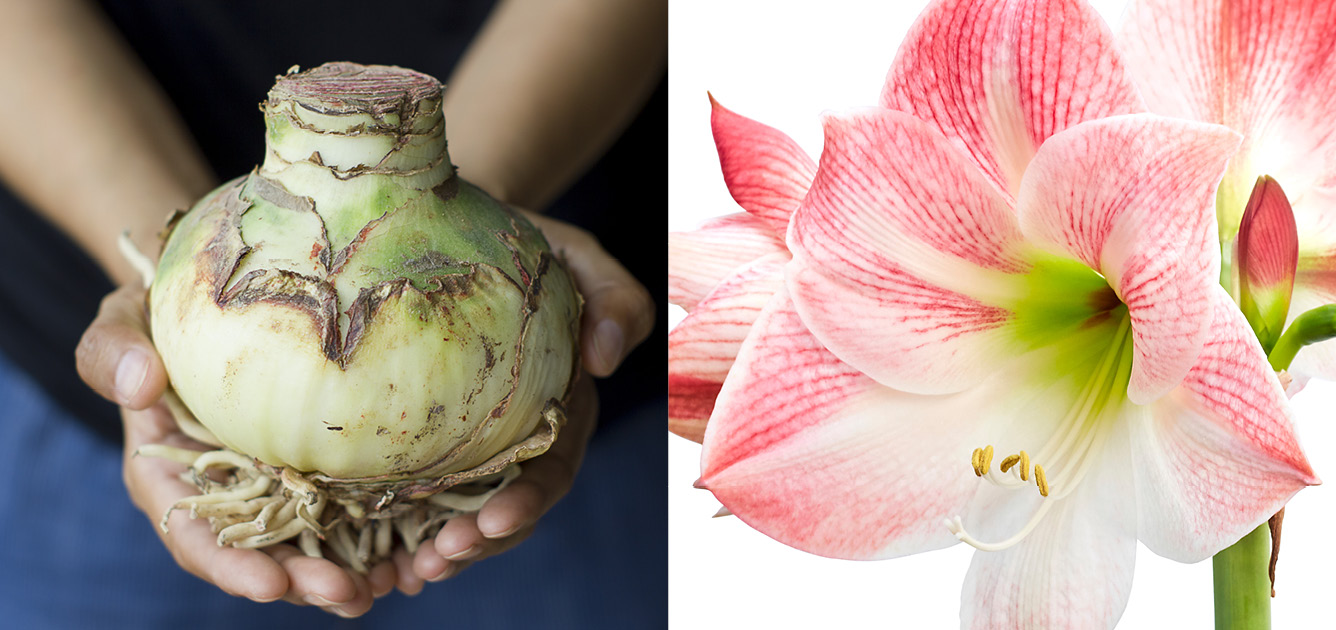With their exotic trumpet-shaped blooms, Amaryllis offer a touch of elegance during winter days.

Autumn is the perfect time to plant Amaryllis, giving them time to establish before they grace us with their floral elegance. Often available in vibrant colours, their long flowering period make them the perfect antidote to dull, grey winter days.
Originating from the tropical regions of South America, they are also known by their botanical name, Hippeastrum. Their large, sophisticated flowers and ease with which they can be brought to bloom make them popular gifts, especially at Christmas.

Amaryllis comes in many beautiful varieties, with flower shades ranging from deep burgundy, through various shades of red, pink, salmon and white. There are also many striped and multi-coloured varieties, usually combining shades of pink or red with white.
Of all flowering bulbs, Amaryllis are the easiest to bring to bloom. Being a tender bulb in the UK, this is best accomplished indoors. Bulbs should be planted from October to January and will flower from six to eight weeks after planting.
Preparation
Amaryllis are usually sold loose or as part of a growing kit, containing everything you need and making them easy to package as a gift. The kit will usually contain a growing medium that requires some rehydration before use, whilst the loose bulbs can be prepared with John Innes No.2 or a multi-purpose compost with added grit. Either way, they must always be planted so that two-thirds of the bulb remains above the soil line in a pot that is slightly wider than the bulb itself.
They sprout best in a well-lit spot that can maintain an average temperature of 21°C (70°F) but will still come to flower in a slightly cooler room, albeit taking longer to do so. Water sparingly until the new leaves develop and then start watering regularly. Do not let the compost dry out and allow to drain fully, taking care to emptying any water that collects in the pot saucer afterwards.
Once the flower stalk develops, turn the pot regularly to prevent it growing towards the light. It’s also a good idea to stake the stems of larger varieties for some added support. When the flower buds are fully developed, move to a cooler room of around 15–18°C (60-65°F), to extend the flowering period up to three weeks.

Aftercare
With a little aftercare, Amaryllis can be coaxed into flowering for the following year. A popular method is as follows:
Remove the spent flower spike to the base, keeping the foliage intact. Continue to water regularly, applying a balanced liquid fertiliser weekly. During the summer, place the bulbs in their pots outside, protecting them from direct sun and continue to water them regularly.
In September move the plants to a well-lit position and keep them cooler, at about 13°C (55°F) for eight to ten weeks. Stop any feeding and reduce their watering so that the plant becomes semi-dormant.
After this cool dormant period, cut the remaining old leaves to 10cm (4in) from the neck of the bulb and replace the top 2.5-5cm (1-2in) of compost.
The plants will then be ready to grow again, as if it were a new plant.
Partner plants
With their large exotic flowers, Amaryllis make a perfect display on their own, especially if displayed in a group.
If growing as part of a larger plant collection, try partnering them with interesting low growing foliage plants which can act as a foil for their tall stems. If you can start them early enough, they’ll also work well with evergreen Christmas-themed garlands draped around their base.
- Plant from late September until the end of January.
- Flowers within 6-8 weeks of planting, from late December until the end of April
- Larger bulbs produce more flowers
- Always store un-planted bulbs in a cool place between 4 - 10 °C (40 - 50 °F)
- Can be coaxed into flowering in subsequent years.

More information
For more information on other houseplants that are suitable for your home, including those that are pet safe, refer to our handy leaflet here.


